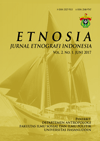Abstract
The occurrence of violence in South Sulawesi whereever they are, they are usually identified as violence that happen in Makassar. This is due to the fact the frequent of violence happen in Makassar than in other cities in Indonesia. This article aims to explore collective violence in two adjoining locations in Makassar, yakni Pampang dan Sukaria and how this is related to masculinity. The pattern of collective violence between people in both areas based on classification and motivesof conflict between groups. The motive of collective violence, namely yakni seizure of land, this then develop mass coordination established through the process of patronage relations and the formation of strong lokal men. This then lead to establishment of routine violence which hands in hand in hand with siri’ na pacce. The construction of masculinity from male perspective that women are obliged to maintain such values through violent ways. Parenting pattern tends to be permissive towards violence. Such violence is common among male members of society. This violence has become an expression of masculinity. Masculinity is symbolised through four aspects: badik, bow arrow, tatto’ dan ballo (a local drink). Thus, one who can performs these aspects will be considered as rewa.References
ASKI. (2013). Pemetaan Aktor-Aktor Kekerasan Kepemudaan dan Sejarah Kekerasan Kepemudaan di Jakarta, Yogyakarta dan Makassar. Jakarta: Kementerian Pemuda dan Olahraga.
Bourdieu, Pierre. (2010). Dominasi Maskulin (Terj.). Yogyakarta: Jalasutra.
Bahar, Ahmad & Sujibto, Bernando J. (2013). Rusuh Makassar: Membaca Pola-Pola Kerusuhan Di Makassar. Jakarta: Solusi Pubhlising.
Darwin, Muhadjir. (1999). Maskulinitas: Posisi Laki-Laki dalam Masyarakat Patriarkis. Yogyakarta: Center For Population and Policy Studies, Universitas Gadjah Mada.
Dharmawan, Arya Hadi. (2007). Konflik-Sosial dan Resolusi Konflik: Analisis Sosio-Budaya (Dengan Fokus Perhatian Kalimantan Barat). Disampaikan pada Seminar dan Lokakarya Nasional Pengembangan Perkebunan Wilayah Perbatasan Kalimantan, 10-11 Januari, Pontianak.
Galtung, Johan. (1999). Kekerasan kultural dalam Wacana Kekerasan dalam Masyarakat Transisi, Yogyakarta: Insist Book.
Harders, Cilja. (2011). Gender Relation, Violence and Conflict Transformation. In B. Austin, M. Fischer, H.J. Giessmann (eds.). Advancing Conflict Transformation. The Berghof Handbook II. Opladen/Farmington Hills: Barbara Budrich Publishers, www.berghof-handbook.net, diakses tanggal 15 Agustus 2014.
Hasse, J. (2012). Anarkisme Demonstrasi Mahasiswa: Studi Kasus Pada Universitas Islam Negeri Alauddin Makassar. Program Studi Ilmu Agama & Lintas Budaya. Sekolah Pascasarjana UGM, Yogyakarta.
Le Bon, Gustave. (2001). The Crowd: A Study of Popular Mind. Kitchener: Batoche Books.
Manji, Taufik. (2011). Studi Analisis Peran Pemerintah Kota Terhadap Perkelahian Antar Kelompok Di Kota Makassar. Skripsi, Program Studi Ilmu Pemerintahan FISIP, Universitas Hasanuddin, Makassar.
Merdeka, Pita. (2013). Senjata Api dan Maskulinitas Dalam Cerita Pendek The Man Who Was Almost A Man. Fakultas Adab dan Humaniora, Universitas Islam Negeri (UIN) Syarif Hidayatullah, Jakarta.
Santoso, Thomas. (2002). Teori-Teori Kekerasan. Surabaya: Penerbit Ghalia Indonesia.
Sardiman, A.M. (2007). Interaksi dan Motivasi Belajar Mengajar. Bandung: Rajawali Pers.
Sahab, Ali dan Muzaqqi, Fahrul. (2012). Analisis Kultural-Politik Kekerasan Mahasiswa di Kota Makassar. Universitas Airlangga, Surabaya.
Tohari, Amien; Yuda Saputra, Dany; Novrian S, Didi; Yanuardy, Dian; Taschler, Lisa; Muntaza; Swanvri; dan Soumahu, Rio. (2011). Dinamika Konflik dan Kekerasan Di Indonesia. Jakarta: Institut Titian Perdamaian.





